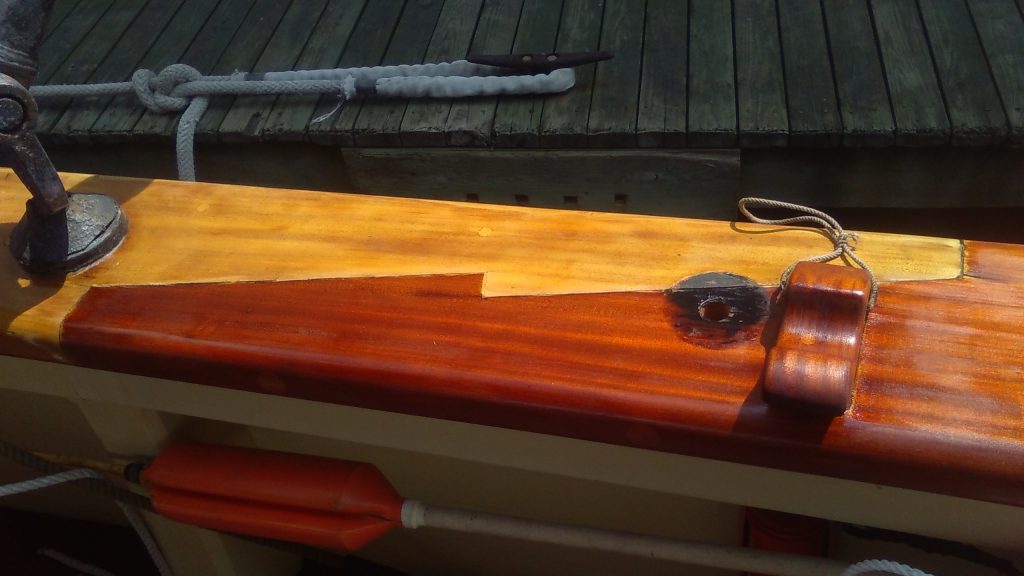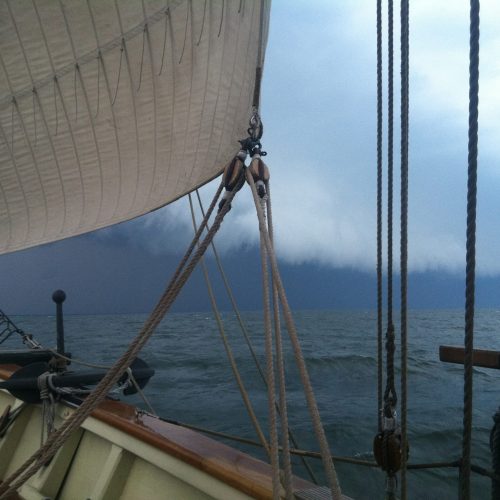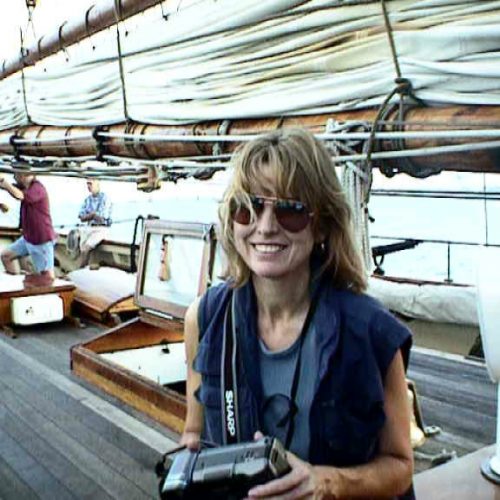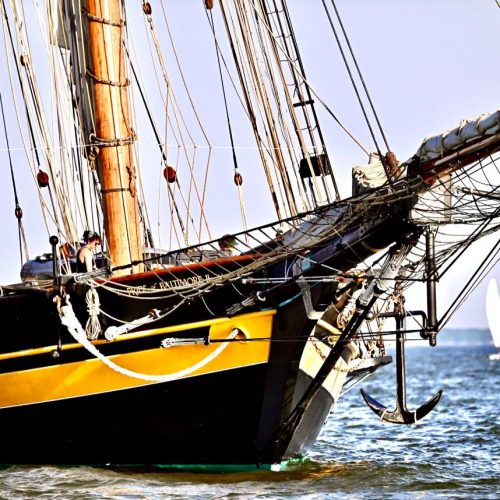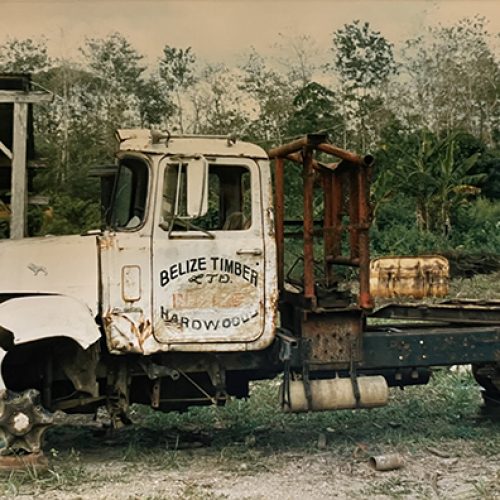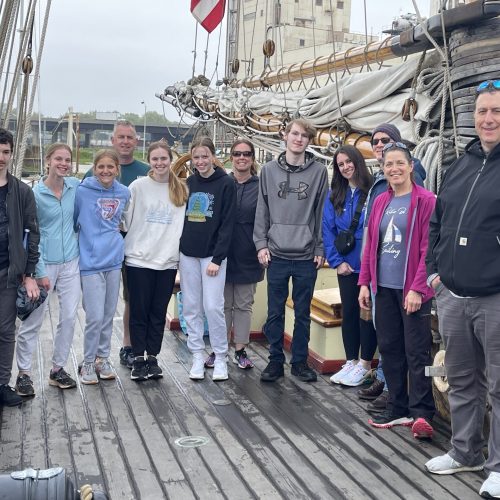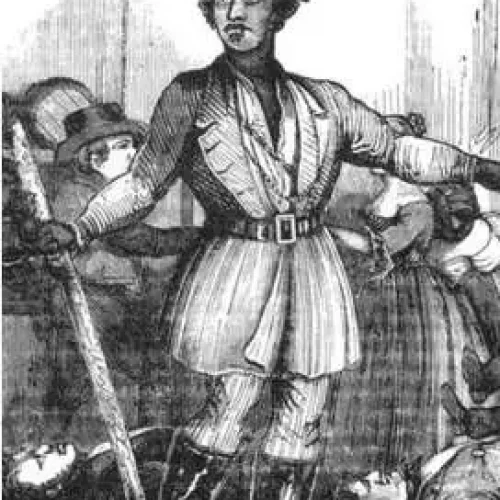A Day in the Life
We write a lot about the big things we do: races to Bermuda in big wind, huge festivals with thousands of people, and the like. Those things are, deservedly, the highlights of a given season, and a large part of why we do what we do. However, the life of this vessel and her people is mostly not things like that. It is, in part, preparation for (and repairs from) things like that, through constant maintenance, upgrade, repair, and many small refinements, but it is also the fulfillment of the rest of the ship’s mission: interacting with the public, representing our state, and educating the youth of this area. What follows is an example of what a day aboard ship is like, here in our home port of Baltimore.
A Maintenance Day
A large portion of our days any given season are, of course, taken up with operating the ship. This might consist of traveling to a new port, hosting a charter, doing a public day sail, participating in a race, attending a government function or ceremony, et cetera. Interspersed between those days (sometimes all too infrequently) are days when the ship is not engaged to do any particular thing. Almost always, these days are given over to maintenance. Maintenance on a large wooden vessel is constant. Indeed, it very often happens on portions of days in which we are also traveling, or doing a charter, or interacting with the public. But, when possible, we give entire working days to it.
Mid-summer in Maryland, for those of us who work outside the region, is a time to carefully monitor our pace, so we don’t get fried. I used to work for a rigging shop in Annapolis. One of our project managers was a South African emigre. It is very hot there in summer, he had a lot of experience in dealing with this, and so he told us: “Go slow.” So, any given hot work day in July, I tell the crew: “Go slow.”
Our work day typically begins at 8 AM. Already, today, the sky has that coppery hue which promises heat. Pride is at her work dock in Canton. It is a Maryland Port Administration facility, which they very generously let us use as a dock and work site. We have several containers full of spare parts, tools, old sails, and repair materials here. The ship has both her awnings up – this means the deck is shaded from stern to foremast, around 3/4 of her total length, which helps both keep the crew out of the sun and keep the sun off the deck, which in turn keeps it cooler down below by as much as 10 degrees.
The deciding upon and prioritizing of maintenance and repair projects (the “what” and “when”) is primarily done by Pride‘s two captains, after either seeing things for ourselves or conferring with the ship’s officers. The day to day management of the crew in carrying these things out (the “who” and the “how”) is done by our first mate, Jeff Crosby, though it is fair to say there is some overlap here, a sort of three circle Venn diagram. On this particular day, Jeff assigns the crew the following projects:
- Stripping the varnish off the caprail. The maintaining of the ship’s varnished surfaces (“brightwork” in nautical parlance) is a constant job. UV sunlight eventually wrecks the varnish, it dulls and then peels, after which the sun attacks the wood beneath. So, periodically, we lightly sand and add another coat to the existing varnish. This works well for a while, but after a few years the ever-thickening coats of old varnish tend to yellow and fade. This process from day to day is not noticeable. It changes at such an incremental rate that you can’t see the difference unless you look at old pictures. But, we did. This led us to completely strip a small surface to bare wood and re-coat it. The difference was striking. Instead of faded and yellowish, the wood was a deep, rich reddish blonde, showing the intricacies of the wood grain – absolutely beautiful. Having thus made a good spot, it was resolved to do the entire caprail (the rail that runs atop the bulwark around the perimeter of the ship). So, several crew are using heat guns (essentially, supercharged hair dryers) to heat the old varnish til it melts, and scrapers to remove it. After that, the bare wood is sanded to make it ready to begin coating with fresh varnish.
- Tarring the rig. There is a common thread thus far: protection. Our standing rigging is mostly galvanized wire. To protect it from corrosion, we coat it with a tar mixture. Sometimes this nasty stuff is laid directly onto the wire (as with the forestays) and sometimes, when a given piece of rigging is originally made, the wire is wormed, parceled, and served first (as with the shrouds) to provide additional protection. “Worming” is laying small stuff (string, basically) into the spiraling gap between the wire strands to provide a smooth surface, “parceling” is wrapping the wire with strips of some flat stuff like canvas or sometimes friction tape, and “serving” is tightly wrapping the whole works with marline. This is a process that has been around in the world of sailing ships for a long, long while, and it is still effective. After this is done (if it is done) the whole works is tarred, to provide a final, protective seal. Tall ships have “gearheads” as ardent as any motorcycle club, and one of the things up for constant debate is the best mixture for tar. Most often, it is varying proportions of tar (preferably Stockholm tar, but it’s pricey) linseed oil, turpentine, and Japan drier, though I’ve heard of plenty of variations. If asked to evaluate on the basis of workability, longevity, and the like, I can’t seem to tell one variation of this witch’s brew from another, which is probably why the ardent debate continues. Just like any other protective coating, it wears out, and we add more coats, getting very, very dirty in the process.
- Replacing running rigging. Kelsey Mullin, who many of you have probably seen pictures of climbing here and there in our rig, is the bosun. This is an old term, a bowdlerization of “boatswain.” Bosuns, in tall ships, are usually responsible for the ship’s small craft and rigging. The rig involves periodic inspection and a nearly constant effort to control and deal with the effects of chafe and UV sunlight. Today, Kelsey is replacing our foresail sheets with new line. Over time, the old line loses its strength due to UV damage, and gets worn out from constantly rubbing its way through blocks, chafing on nearby rigging, getting walked on, having salt crystals worked into the fiber, et cetera. Replacing the line, in this case, involves un-stringing the old stuff from its four part purchase, measuring its overall length, splicing loops where needed into the new line, and re-leading the whole thing.
- The engineer. Charles Reynolds is our engineer this year, and was for half of last year. Pride, though she is very traditional in her hull shape and rig, has a lot of modern equipment crammed below her deck. Charles spends a fair amount of time waist deep in this compartment or that, making sure it all works, with occasional breaks to pester me for parts. Today, he is fixing our fresh water system.
- The “duty.” Every day, regardless of what we do, a member of the crew does what’s called “the duty” (with suitable overtones of dread). Everyone in the crew except for the captain, the first and second mates, and the cook, rotate through doing this. It is basically the cleaning and organization of the cabin spaces – assisting the cook with the dishes, cleaning the galley, mopping the floor, wiping down other surfaces, polishing the copper flashing behind the stove, cleaning the heads, and so on. This takes a significant portion of the day. Whoevers turn it is spends a large portion of the day below, therefore. Often, but not always, they pick good music to play while they work. Yesterday, for instance, I went to get a glass of ice water and was treated to “Misty Mountain Hop” playing in the salon, which made me happy.
- And me? I observe it all, I offer guidance when needed, I work on filling our upcoming deckhand slots, I code receipts, and I write to you nice people.
Signed,
Captain Jordan Smith

